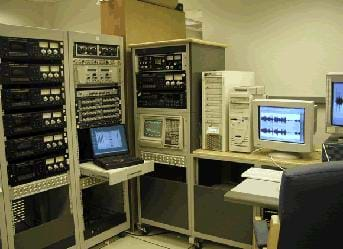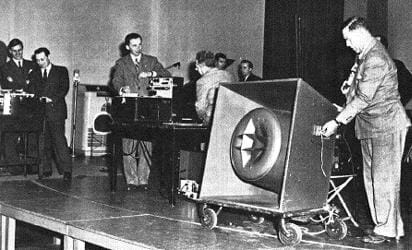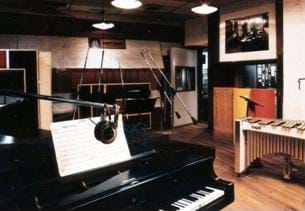Quick Look
Grade Level: 4 (3-5)
Time Required: 15 minutes
Lesson Dependency: None
Subject Areas: Science and Technology

Summary
Students are introduced to audio engineers, discovering the type of environment in which they work and exactly what they do on a day-to-day basis. Students come to realize that audio engineers help produce their favorite music and movies by practicing similar techniques to prepare for a recording session as shown in the associated activity.Engineering Connection
Audio engineering has a long history intertwined with pop culture, through both music and movies. Audio engineers help musicians, actors and other professionals record music and sounds for entertainment purposes. They design the rooms in which recordings take place as well as the microphones and recording equipment.
Learning Objectives
After this lesson, students should be able to:
- Relate audio engineering to music and film.
- Explain that audio engineers manipulate sound by using their scientific knowledge of sound.
Educational Standards
Each TeachEngineering lesson or activity is correlated to one or more K-12 science,
technology, engineering or math (STEM) educational standards.
All 100,000+ K-12 STEM standards covered in TeachEngineering are collected, maintained and packaged by the Achievement Standards Network (ASN),
a project of D2L (www.achievementstandards.org).
In the ASN, standards are hierarchically structured: first by source; e.g., by state; within source by type; e.g., science or mathematics;
within type by subtype, then by grade, etc.
Each TeachEngineering lesson or activity is correlated to one or more K-12 science, technology, engineering or math (STEM) educational standards.
All 100,000+ K-12 STEM standards covered in TeachEngineering are collected, maintained and packaged by the Achievement Standards Network (ASN), a project of D2L (www.achievementstandards.org).
In the ASN, standards are hierarchically structured: first by source; e.g., by state; within source by type; e.g., science or mathematics; within type by subtype, then by grade, etc.
International Technology and Engineering Educators Association - Technology
-
Explain how various relationships can exist between technology and engineering and other content areas.
(Grades
3 -
5)
More Details
Do you agree with this alignment?
State Standards
Colorado - Science
-
Identify and describe the variety of energy sources
(Grade
4)
More Details
Do you agree with this alignment?
Pre-Req Knowledge
Students should understand that sound travels in waves and has a direction of travel. This lesson works well accompanying a science unit on sound or waves.
Introduction/Motivation
Have you ever noticed that the music coming from your MP3 or CD player sounds so clear? Musicians put a lot of effort into creating a perfect tune, and, likewise, much effort is put into recording it just as perfectly. In what sort of room should the recording take place? What material should be on the walls in the recording studio? At what angles should these walls face? Where should the microphones be located to pick up the best sound? How loud should the musicians play? These and other questions all refer to different variables — something that can be changed — that audio engineers consider. Audio engineers weave these different variables together to create a tapestry of sound.
Audio engineers work in music recording studios and work on the audio portions of films. Perhaps the singer in a band wants an echoed voice or maybe the drums are too loud and need to be "turned down." Audio engineers can adjust these variables. They can also create new sounds and add them to the music mix, such as a strumming guitar layered into the background. Refer to the activity Musical Images to have students practice creating their own studio set-up to acheive a certain sound.
Academy Award winner Tom Johnson is an audio engineer who created the sounds of the pod-racers of Star Wars Episode I. What other components of that movie do you suspect he worked on as part of his job? (Possible answers: Sound levels of the dialogue, sounds of the light sabers, the starship doors opening and closing, etc.)
What do audio engineers rely on everyday to make sounds? Yes, you're right — the physics of sound. This includes knowing how sound waves travel and specifically how they change as they travel through air and bounce off different objects. Audio engineers know all about how sound travels. They use this knowledge to create sound effects for music and movies.
Lesson Background and Concepts for Teachers
The first audio engineers strived to capture the perfect sound for a play-back that was indistinguishable from a live performance. From the time sound was first recorded by Thomas Edison's spinning cylinder in 1877 to the formation of the Audio Engineering Society (AES) in 1948, giant leaps in technology have been made to enhance sound. The most important event leading to the formation of the AES was in 1947 when electrical engineering graduate Jack Mullin successfully demonstrated a device that recorded sound onto a strip of magnetic plastic tape. Mr. Mullin was chosen to record Bing Crosby's radio show — an opportunity that produced unprecedented sound quality and playing time.

While realistic sound quality remains a strong ambition, new areas of interest have since emerged in audio engineering. Current contemporary audio engineers add intensity, drama and other artistic effects to sound. Others create new technology that allows musicians and sound designers to create innovative sounds that have never been heard before. Indeed, the horizon of sound possibilities for film and music makers is almost endless thanks to the creative work of audio engineers.

Associated Activities
- Musical Images - Students learn about the concept of musical images and simulate audio engineering by modeling the position of microphones over a drum set to create a desired musical image.
Lesson Closure
Who benefits from the work of audio engineers? (Possible answers: Musicians, filmmakers and the general public.) You are part of the general public. What must audio engineers know to help adjust sounds until they are what musicians and filmmakers desire. (Answer: They use their knowledge of the physics of sound, or how sound travels and how sound changes as it bounces off of objects.) Can you think of a movie or song with sound effects that you especially like? Tell us about those sounds and why they are important (to the movie or music). (Listen to student descriptions.) Who helped create all these amazing sounds?" (Hopefully everyone answers: Audio engineers!)
Vocabulary/Definitions
audio engineer: A person who records and creates sound and sound technology.
microphone: A piece of equipment that collects sound.
sound studio: A room where sound is recorded and produced for either music or film.
variable: Something that can be changed.
Assessment
Pre-Lesson Assessment
Discussion Question: Solicit, integrate and summarize student responses.
- Why does the music coming from your radio or MP3 player sound the way it does?
Post-Introduction Assessment
Observation: Ask students to comment on the following question:
- Has your voice ever been recorded? Does it sound like you?
Brainstorming: As a class, have students engage in open discussion. Remind them that in brainstorming, no idea or suggestion is "silly." All ideas should be respectfully heard. Encourage wild ideas and discourage criticism of ideas. Have students raise their hands to respond. Write answers on the board. Ask the students:
- What are the kinds of questions an audio engineer might ask in order to set up a sound image for a song recording? (Possible examples: In what sort of room should the recording take place? What material should be on the walls? At what angles should these walls face? Where should the microphones be placed? How loud should everyone play?)
Lesson Summary Assessment
Vocabulary: Ask students to write down the vocabulary words and definitions on paper or in science journals.
Where Are They?: Ask students and make a class list on the board of all the different places where an audio engineer might work. (Possible answers: A recording studio, movie studio, film set, television studio, auditorium, concert hall, radio station, concert hall, sports stadium, etc.)
Lesson Extension Activities
Internet and/or Library Research: Have students research Jack Mullin, the person who brought America tape recording technology. Answer the question: How did he arrive at his unique technology? (It's an interesting story!)
Journal Writing: Consider the following question: How do you think musicians, filmmakers and the general public benefit from technology to record sound? Does one group benefit more than another?
Subscribe
Get the inside scoop on all things TeachEngineering such as new site features, curriculum updates, video releases, and more by signing up for our newsletter!More Curriculum Like This

Students are introduced to the concept of the image of music. After listening to a song, they draw images of it by deciding where different musical instruments were placed during recording. They further investigate audio engineering by modeling the position of microphones over a drum set to create a...

Students learn about sound with an introduction to the concept of frequency and how it applies to musical sounds.

Filtering is the process of removing or separating the unwanted part of a mixture. In signal processing, filtering is specifically used to remove or extract part of a signal, and this can be accomplished using an analog circuit or a digital device (such as a computer). In this lesson, students learn...

Students are introduced to the sound environment as an important aspect of a room or building. Several examples of acoustical engineering design for varied environments are presented.
References
Audio Engineering Society Historical Committee, "Audio Engineering History: Timeline," June 12, 2008. Accessed July 3, 2008. http://www.aes.org/aeshc/docs/audio.history.timeline.html
Koenig, Bruce E., Douglas S. Lacey and Noel Herold. Published April 2003. "Equipping the4 Modern Audio-Video Forensic Laboratory." Forensic Science Communications. Volume 5, Number 2. Accessed November 24, 2010. http://www.fbi.gov/about-us/lab/forensic-science-communications/fsc/april2003/lacey.htm/
The Library of Congress. http://www.americaslibrary.gov/cgi-bin/page.cgi/es/mi/motown_1
Morton, David L., Recording History, The History of Recording Technology, "The Era of Tape Recording," 1998-2006. Accessed July 3, 2008. http://www.recording-history.org/HTML/musictech6.php
Copyright
© 2008 by Regents of the University of Colorado.Contributors
Michael Bendewald; Malinda Schaefer Zarske; Janet YowellSupporting Program
Integrated Teaching and Learning Program, College of Engineering, University of Colorado BoulderAcknowledgements
The contents of these digital library curricula were developed by the Integrated Teaching and Learning Program under National Science Foundation GK-12 grant no. 0338326. However, these contents do not necessarily represent the policies of the National Science Foundation, and you should not assume endorsement by the federal government.
Last modified: May 27, 2019









User Comments & Tips